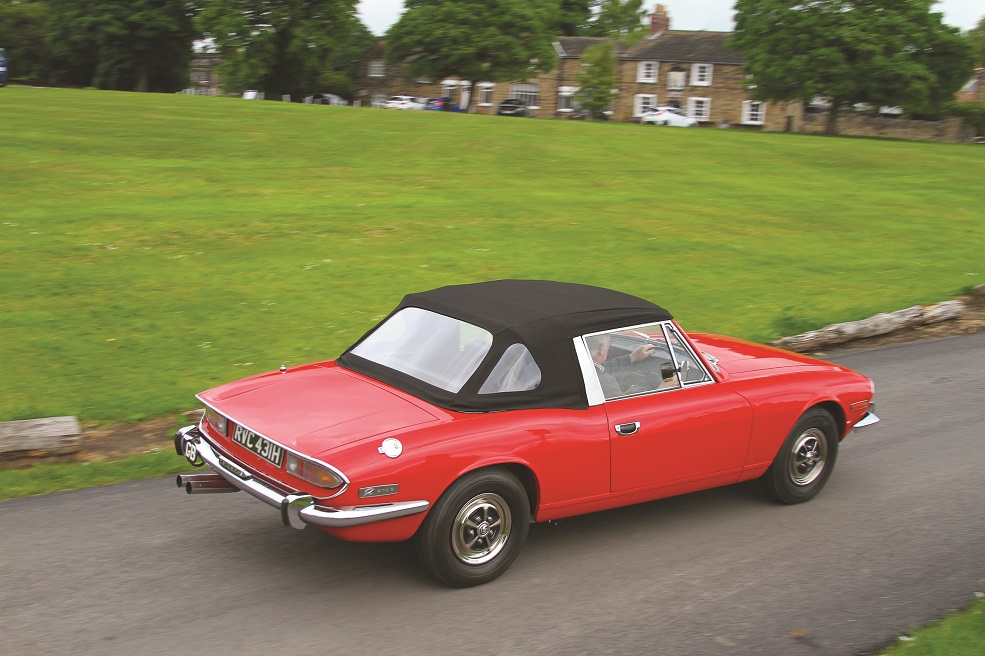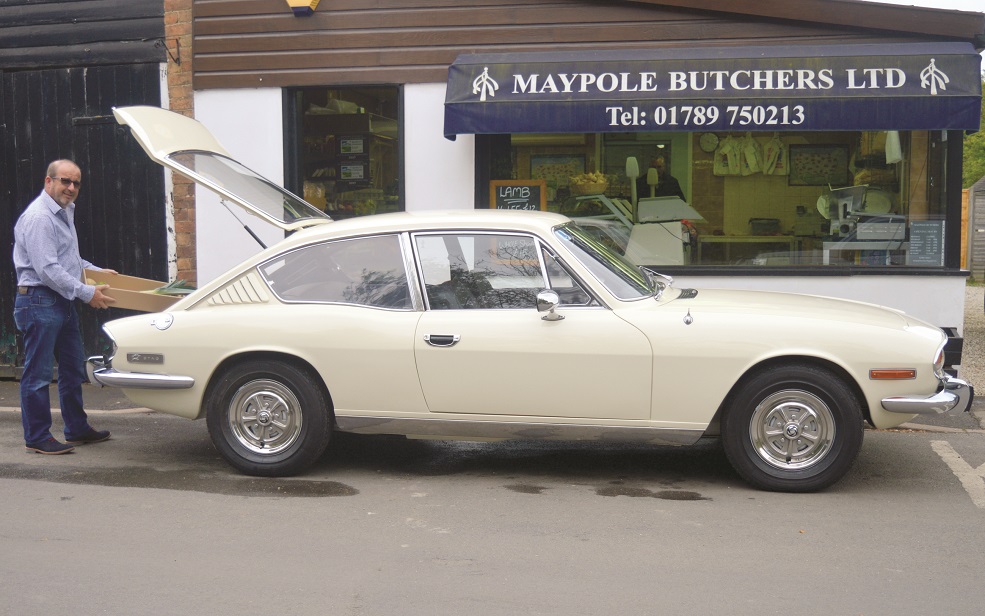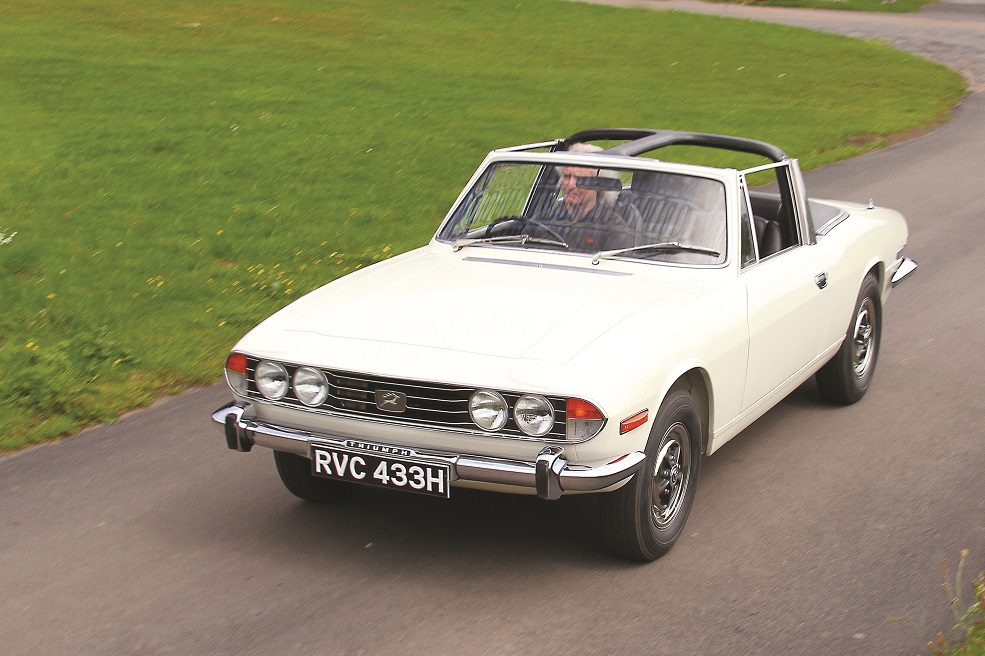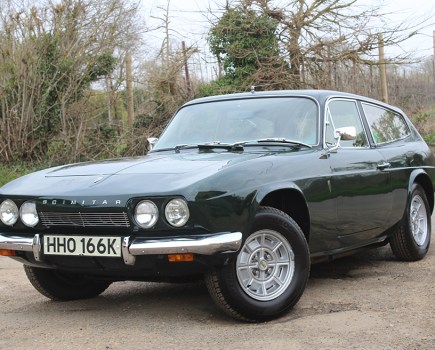The Triumph Stag has been a stalwart classic car for decades. We list the top 10 things you need to know about the Stag.
- The car that Michelotti was given to create his show stopper was registered 6105 KV, a 2000 saloon that had been taken off the production line in early 1964 to act as a company hack. It was used to support Triumph’s 1965 Le Mans effort, towing Spitfire ADU 63B to the event. After returning ADU 63B and the trailer to Calais after Le Mans, it was then driven to Michelotti in Turin. The same car returned to Michelotti in late 1968 when Triumph asked him to have a go at creating a fastback version of the Stag. In all there were three attempts to get this right, the final and very stylish one done in-house by Triumph’s Les Moore. This car still survives, but sadly it was never put into production.
- Michelotti’s original show-car design had the putative Stag’s four headlights hidden behind screens that mimicked the radiator grille. When the lights were switched on, electric motors slid these covers towards the centre of the car and behind the grille. These persisted well into 1968, and were also tried out on at least one of the Triumph 2000 Mk2 styling cars. Fortunately, (we are not big fans of the look!) US lawmakers and problems with the motors burning out if there was ice in the sliding channels knocked that idea on the head.
- When Harry Webster first brought Michelotti’s show car back from Italy, it was briefly referred to as the TR6 within Triumph. The concept was clearly more of a Grand Tourer than a sports car in the TR mould though, and any reference to the TR line was quickly dropped. Triumph always gave their projects random four-letter names to help hide developments from prying eyes, and this one was given the code name Stag. Then everybody decided they liked the Stag name so much that it made it all the way through to production, the only known instance of this happening.

Another of the first batch cars produced, this is LD10. Note the lack of stripes and sill trim, the fake Rostyle wheels and rear quarterlights.
- Despite being based on a 2000 saloon, the cumulative changes made to create a 2+2 cabriolet and build in enough strength to stop it folding in two meant that not a single panel was interchangeable between the two. That is hardly surprising when you think that the Stag had only two doors, no roof, a shorter wheelbase and longer overhangs, but while the Stag was planned for production in 1968, it was bumped down the pecking order by a number of other projects being given priority, including a facelift for the saloons. As a result, the Mk2 2000/2500 appeared first and it looked as though the Stag inherited that car’s styling, when in fact the updated saloon had taken its styling cues from the Stag.
- There was never any question – or any interest – within Triumph for using the Stag in motorsport where, as Graham Robson pointed out to us, it would have been too heavy and under-powered to have been competitive against cars like the Mercedes-Benz 350SLC. Besides, the Stag could only have been homologated in Group 3 (it didn’t have high enough sales for Group 1, and in any case it wasn’t a saloon,) where in 1971-1973 the principal opposition came from the latest Porsche 911. Yeah, we wouldn’t have fancied our chances there, either…! However, it was rallied successfully in the USA by Renee and Jack O’Leary, while in the UK Tony Hart entered a Stag in the Modsports Championship from 1979 to prove its durability. And in recent years a well-prepared Stag in the hands of Phil Garratt and Kieron Brown has been winning acclaim on long distance historic rally events.
- In 1972, Ferguson converted two Stags to four-wheel drive, one a manual car and the other an automatic. They fitted their own 4WD system plus Dunlop Maxaret anti-lock brakes (similar to that used on the Jensen FF) which they were marketing as a package. This package later ended up in the Ford Sierra 4×4 and Jaguar XK220. In the Stag they bolted a simple transfer box to the back of the gearbox, with a viscous coupling filled with an unusual oil that gets stiffer as it gets hotter. This allowed a bit of slippage between front and rear axles to stop the car winding itself up. Both 4×4 Stags survive in the hands of enthusiasts today.

This Stag is one of the two 4×4 examples, and shows the great lines of the factory hardtop.
- A Stag from the BL press fleet was used in the filming of the James Bond film, Diamonds are Forever, in 1971. The film sees Sean Connery as James Bond taking the Stag across to the continent on the hovercraft The Princess Margaret, en route to Amsterdam for a meeting with Tiffany Case (actress Jill St John). When she opens the door rather scantily clad, Bond says: ‘That’s quite a nice little nothing you’re almost wearing. I approve.’ As poor as the dialogue might sound today, it wasn’t the movie’s only assault on the audience’s aural sensibilities – the sound effects team didn’t make too much effort with the soundtrack and gave the Stag a four-cylinder exhaust note!
- The Stag was given a very stylish and very snug hardtop option which earned praise from testers for the added refinement this provided. Very often if a hard top was fitted, then the car also had a soft top hidden below its metal cover behind the rear seat. We have heard anecdotal stories from within the motor trade of customers who knew nothing about this asking for their Stags to be turned into soft tops, and being charged outrageous sums for the privilege. The stories are only anecdotal though, and we would love to hear from anybody who can categorically state from personal experience that this actually happened!

It took Triumph three goers to perfect the fastback Stag, but they didn’t put it into production.
- Why was the Stag V8’s water pump mounted so high on the engine that even a small loss of water could end up with catastrophic overheating – surely the Triumph engineers would have known about the dangers? Well, blame Saab. The original V8 proposal had a belt-driven water pump mounted on the front of the block, but when Saab needed to turn the related slant 4 around through 180 degrees to put their gearbox ahead of it in the FWD Saab 99, there was no longer room for the water pump and pulley between the engine and Saab’s bulkhead. So Triumph had to put it on top of the cylinder block to suit both orientations, driven by a shaft that also drove the distributor and oil pump, and would have been used for a metering unit had they gone ahead with fuel injection.
- Although the Stag represented a totally new market offering and was never effectively replaced, Triumph did come close to creating a follow-on act, even if it was to be a coupe rather than a convertible. This was the Lynx, which was based on the TR7 at the front but blended into a 2+2 fastback body at the back. It would not have used the Triumph V8 engine though, as the plan was to offer it either with the four-cylinder O-series engine and MG badges, or powered by the Rover V8 with Triumph badges. The design showed promise, but was killed off in 1978, one more victim of the Speke factory closure.

An H-plate and RVC Coventry registration – this is LD12, one of the Stags built prior to launch.





